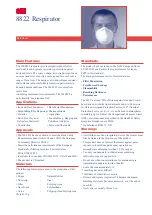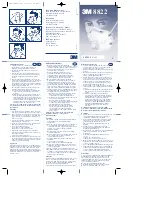
INSPECTION
INSPECTION
Inspect the entire SCBA after it is cleaned and disinfect-
ed. NFPA-1500, as well as ANSI Standards Z88.2 and
Z88.5, describe three levels of inspection procedures
which are to be performed. Refer to these documents, or
to an inspection program prepared by a health profession-
al in establishing an inspection program. Detailed repair
procedures are located in MMR Users Maintenance
Instructions.
If the air mask does not function properly during any
of the following inspections, it must be removed from
service.
Do not inspect the air mask before cleaning if there is
danger of contacting hazardous contaminants. Clean
and disinfect first, then inspect. Failure to follow this
precaution may cause inhalation or skin absorption of
the contaminant and result in serious personal injury
or death.
COMPONENT INSPECTION
(AFTER EACH USE AND MONTHLY)
1. Don the air mask following the instruction procedures.
These steps make up the Air Mask Functional Test.
2. If all steps are performed successfully, remove the air
mask and inspect it following the steps below.
3. Facepiece
a. Inspect the facepiece for rubber deterioration, dirt,
cracks, tears, holes, or tackiness.
b. Check the harness headstraps for breaks, loss of
elasticity, or missing buckles or straps. Check the
straps for signs of wear.
c. Inspect the lens for cracks, scratches, and a tight
seal with the facepiece rubber.
d. The exhalation valve must be clean and operate
easily. The valve must move off the seat and return
when released.
e. Inspect the facepiece coupling for damage. Also
check to be sure the spider gasket and valve disc
are present.
f. Inspect the NightFighter Heads-Up Display System
Receiver module. Check for cracks or other signs of
damage which could allow contaminants to enter
the module housing.
4. Cylinder
Gauge
a. Be sure you can see gauge needle and face clearly
through the lens. Also be sure the gauge stem is
not bent.
b. Inspect the gauge hose for any visible damage.
5. NightFighter Heads-Up Display System
a. Check that the NightFighter Heads-Up Display
System goes through LED light patterns when cylin-
der valve is opened. This test assures that the
NightFighter Heads-Up Display System is operating.
6. High Pressure Hose
a. Check the high pressure hose between the
NightFighter Heads-Up Display System Transmitter
and first stage regulator. Check for cuts or severe
abrasions. If present, replace the hose, the hose fit-
ting should be tight.
7. Cylinder
Breathing apparatus cylinders should be recharged as
soon as possible after use. Cylinders should not be
stored partially charged for two reasons:
• If used without recharge, the service life of the
apparatus is reduced.
• The cylinder burst disc vents excess pressure if a
full cylinder is over exposed to fire or heat. If the
cylinder is not full, it may be damaged before the
burst disc vents.
It is also essential that the required inspections and tests
be performed on all SCBA cylinders in accordance with
Department of Transportation (DOT) regulations. DOT reg-
ulations require that composite cylinders be retired from
service after the fifteenth year. Please note this does not
include cylinder valve assembly which may be reused.
Aluminum cylinder service life is indefinite if proper
inspection and hydrotest procedures are followed and
they indicate that the cylinder may remain in service.
Please contact your MSA distributor or sales associate if
you have questions or if you need additional information
regarding this policy.
Note:
ANSI Z88.5 recommends checking cylinder pres-
sure weekly. For maximum safety the cylinders should be
stored full or empty (pressure above ambient but less than
100psig).
a. If the cylinder is less than FULL, recharge it before
storing it. Cylinder air must be at least CGA Quality
Verification Level (Grade) D respirable air.
b. Inspect the cylinder valve for signs of damage. The
valve may be opened slightly to be sure it operates
properly. Be sure to fully close the valve.
c. Inspect the cylinder body for cracks, dents, weak-
ened areas, corrosive agents causing the fibers to
break or peel, or signs of heat-related damage. If
the cylinder is damaged return it to an MSA Service
Center. Call 1-800-MSA-2222 for instructions.
e. Check the hydrostatic test date on the cylinder
approval sticker located on the cylinder neck.
Fiberglass and Kevlar composite cylinders must be
tested every three years. Steel cylinders and carbon
fiber cylinders must be tested every five years.
8. Harness
Inspect all harness components and shrouds for cuts,
tears, abrasions, or signs of heat or chemical- related
damage.
23
TAL 601 (L) Rev. 5 - 10041214
WARNING
Содержание BlackHawk MMR
Страница 8: ...NOTES 8 TAL 601 L Rev 5 10041214...
Страница 20: ...NOTES 20 TAL 601 L Rev 5 10041214...
Страница 22: ...NOTES 22 TAL 601 L Rev 5 10041214...
Страница 26: ...NOTES 26 TAL 601 L Rev 5 10041214...


































